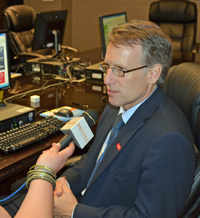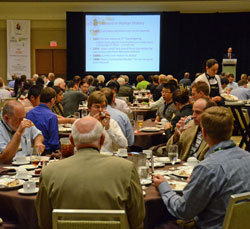 The 2012 Corn Utilization Technology Conference has come to a close and attendance was officially higher than in 2010. It has been a tremendous showcase of all kinds of research being done to continue to make new products and improve others made out of corn which is “Rooted in Human History (pdf).”
The 2012 Corn Utilization Technology Conference has come to a close and attendance was officially higher than in 2010. It has been a tremendous showcase of all kinds of research being done to continue to make new products and improve others made out of corn which is “Rooted in Human History (pdf).”
To close out the conference and give us a wrap-up I spoke with Rick Tolman, CEO, NCGA, seen here delivering his closing remarks a few minutes ago. I would echo his comments about being impressed with the young people attending the conference, many of whom submitted student posters for competition.
Rick says it’s the best of times and worst of times for the corn industry. Best of times because corn growers are on the top of their game, growing the largest crop in the United States which is used worldwide in more products and applications than any other crop. However, Rick says it’s also a tough time for corn growers due to a lot of uncertainties like negative media attention driven by misinformation coming from activist groups who want to change the way we grow corn and grow food. This conference helps get him enthused about the business though when you see how many new ideas are being worked on that will ultimately benefit the industry.
I also asked Rick for his thoughts on the farm bill, partnering with NASCAR and the progress of the U.S. Farmers and Ranchers Alliance which NCGA is a member of. He’s optimistic about all these programs.
Listen to my interview with Rick here: Interview with Rick Tolman
You can find photos from the 2012 CUTC in my online photo album: 2012 CUTC Photo Album

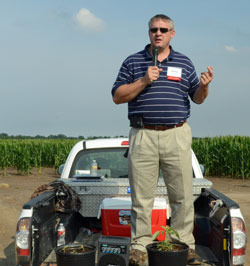 During the 2012 Conservation in Action Tour the word “precision” came up multiple times. As precision ag continues to develop it is being seen as an effective tool for conservation plans and practices. One of our speakers addressed this subject. He’s Terry Griffin, farmer and also VP, Applied Economics for new precision ag company,
During the 2012 Conservation in Action Tour the word “precision” came up multiple times. As precision ag continues to develop it is being seen as an effective tool for conservation plans and practices. One of our speakers addressed this subject. He’s Terry Griffin, farmer and also VP, Applied Economics for new precision ag company, 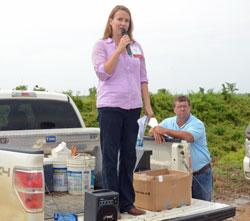 During the afternoon of the 2012 Conservation in Action Tour our speakers talked a lot about how soil and water conservation systems benefit wildlife. One of our presenters was Kay Whittington, Chief of the Mississippi Department of Environmental Quality’s Management Branch, Surface Water Division. Kay says that the same conservation practices that help farmers manage soil and water quality also benefit wildlife. I think this is pretty good common sense. Kay says that she got involved in the tour because of the involvement of Delta F.A.R.M. and says they are her go-to agency for projects on the ground because they have the connections with the local land owners.
During the afternoon of the 2012 Conservation in Action Tour our speakers talked a lot about how soil and water conservation systems benefit wildlife. One of our presenters was Kay Whittington, Chief of the Mississippi Department of Environmental Quality’s Management Branch, Surface Water Division. Kay says that the same conservation practices that help farmers manage soil and water quality also benefit wildlife. I think this is pretty good common sense. Kay says that she got involved in the tour because of the involvement of Delta F.A.R.M. and says they are her go-to agency for projects on the ground because they have the connections with the local land owners.

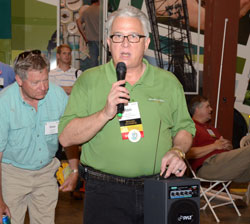 I think he’s the head cheerleader for the
I think he’s the head cheerleader for the 


